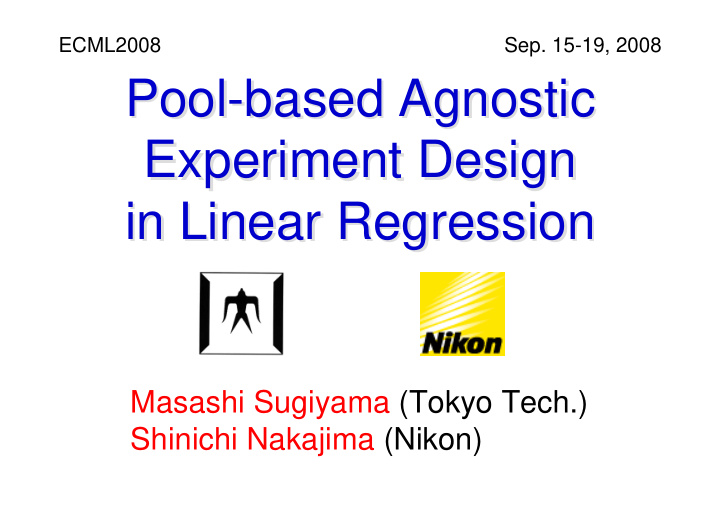



ECML2008 Sep. 15-19, 2008 Pool-based Agnostic Pool-based Agnostic Experiment Design Experiment Design in Linear Regression in Linear Regression Masashi Sugiyama (Tokyo Tech.) Shinichi Nakajima (Nikon)
2 Linear Regression Linear Regression � Learn a real-valued function from input-output training samples . output input
3 Linear Regression (cont.) Linear Regression (cont.) � Linear model is used for learning: : Parameter : Basis function � Goal: learn so that the generalization error is minimized : Expectation over noise :Test input density
4 Experiment Design Experiment Design � Quality of learned functions depends on training input location . Good input location Poor input location Learned Target � Goal: optimize training input location
5 Challenges Challenges � is unknown and needs to be estimated. � In experiment design, we do not have training output values yet. � Thus we cannot use, e.g., cross-validation which requires . � Only training input positions can be used in generalization error estimation!
6 Organization Organization Pool-based Agnostic Experiment Design in Linear Regression 1. Problem definition 2. Basic strategy 3. Proposed method 4. Experiments
7 Bias and Variance Bias and Variance � is not estimable without . � For linear learning : � Noise variance is not estimable without . is computable from . � : Learning matrix
8 Key Trick in Experiment Design Key Trick in Experiment Design � Find a setup where is guaranteed. � Then � Thus computable before observing : Learning matrix
9 Traditional Method Traditional Method (Fedorov 1972) � Assume model is correct: � Use ordinary least squares (OLS) estimation: � Experiment design criterion:
10 Goal of This Work Goal of This Work � Pros / cons of traditional method: + Generalization error estimation is exact. + Easy to implement. - Correct-model assumption is not realistic. - Very poor performance when agnostic. - Test input density is often unknown. � We propose a new method that is � Still easy to implement, � Robust against agnosticity, � Able to work without .
11 Organization Organization Pool-based Agnostic Experiment Design in Linear Regression 1. Problem definition 2. Basic strategy 3. Proposed method Overcoming agnosticity 1. Coping with pool-based setup 2. 4. Experiments
12 Weak Agnostic Setup Weak Agnostic Setup � The model is not exactly correct, but is reasonably good: � Decomposition of target function: Target function Approximable part Residual part
13 Further Decomposition of Bias Further Decomposition of Bias � is constant and ignorable. � But OLS cannot make zero due to “covariate shift”: (Shimodaira JSPI2000) � Training / test inputs follow different distributions. � “Covariate” is another name for “input”.
14 Importance-Weighted LS (IWLS) Importance-Weighted LS (IWLS) Importance � Even when agnostic: � When weak agnostic: � Solution is given by
15 Justification Justification (Sugiyama JMLR2006) � For IWLS � Thus computable before observing
16 Organization Organization Pool-based Agnostic Experiment Design in Linear Regression 1. Problem definition 2. Basic strategy 3. Proposed method Overcoming agnosticity 1. Coping with pool-based setup 2. 4. Experiments
17 Pool-based Setup Pool-based Setup � Pool-based setup: � The test input density is unknown. Importance weight is not accessible. � But a pool of test input samples is given. � Training input points are chosen from the pool. � We assume .
18 Computing Importance Weight Computing Importance Weight � : Resampling probability of � Choose following . � Then can be exactly computed:
19 Proposed Method Proposed Method � Choose resampling function based on � Advantages: � Robust against model misspecification. � Easy to implement.
20 Organization Organization Pool-based Agnostic Experiment Design in Linear Regression 1. Problem definition 2. Basic strategy 3. Proposed method 4. Experiments
21 Wafer Alignment in Wafer Alignment in Semiconductor Exposure Apparatus Semiconductor Exposure Apparatus � Recent silicon wafers have layer structure. � Circuit patterns are exposed multiple times. � Exact alignment of wafers is very important.
22 Markers on Wafer Markers on Wafer � Wafer alignment process: � Measure marker location printed on wafers. � Shift and rotate the wafer to minimize the gap. � For speeding up, reducing the number of markers to measure is very important.
23 Non-linear Alignment Model Non-linear Alignment Model � When gap is only shift and rotation, linear model is exact: � However, non-linear factors exist, e.g., � Warp � Biased characteristic of measurement apparatus � Different temperature conditions � Exactly modeling non-linear factors is very difficult in practice!
24 Experimental Results Experimental Results � 20 markers (out of 38) are chosen by experiment design methods. � Gaps of all markers are predicted. � Repeated for 220 different wafers. � Mean (standard deviation) of the gap prediction error � Red: Significantly better by 5% Wilcoxon test � Blue: Worse than the baseline passive method Pool / Agnostic Pool / Non-agnostic “Outer” Passive Model (Proposed) (Fedorov 1972) heuristic (Random) Order 1 2.27(1.08) 2.37(1.15) 2.36(1.15) 2.32(1.11) Order 2 1.93(0.89) 1.96(0.91) 2.13(1.08) 2.32(1.15) Order 1: Order 2: � Proposed method works the best!
25 Conclusions Conclusions � We proposed a pool-based agnostic experiment design method for linear regression. � Proposed method is � Robust against model misspecification, � Easy to implement. � Proposed method is promising in � Extensive benchmark simulations, � Real-world wafer alignment task. � Come to our poster for technical details!
Recommend
More recommend